Figures & data

Figure 1. Antioxidant activity of the flower bud extracts of different P. japonicus varieties produced in Tokushima.
The extracts from Awaharuka 2016, Misato 2016, Awaharuka 2017, and Kamiyama-zairai 2017 were assayed. Total ORAC values from L-ORAC (closed square) and H-ORAC (open square) (a) and DPPH radical scavenging activity (b). Values were expressed as mean ± SD of three determinations, and different letters indicate significant differences among extracts, p< 0.05 (Tukey–Kramer multiple-range test).

Figure 2. Antioxidant activity of the flower bud extracts of P. japonicus based on the online HPLC-DPPH method.
Antioxidant compounds in the 80% ethanol extracts from Awaharuka were investigated using the online HPLC-DPPH method. HPLC profiles of compounds treated with DPPH or without DPPH (a). UV-vis spectra of six major peaks and tentative commercial compounds (b). The compounds in the extract and authentic compounds were separated on a TSK ODS 80T column and monitored at 325 nm.

Table 1. DPPH radical scavenging activity based on six major peaks in the extracts of P. japonicus (a) and five authentic compounds (b) in . Antioxidant activity was examined using the online HPLC-DPPH method.
Table 2. UPLC-MS data of the antioxidant compounds detected and estimated in authentic compounds in .
Figure 3. Spectra data of UPLC-MS and MS/MS analysis of peak 3.
UV-vis spectrum (a) and MS spectra with ES negative (b) and positive mode (c). MS/MS spectra data showing the molecular ion mass of a parent ion as 435.2 with ES positive mode at 30 V (d) and as 433.3 with ES negative mode at 30 V (e).

Table 3. Concentrations of antioxidant compounds in the flower bud extracts of various P. japonicus varieties produced in Tokushima.
Figure 4. Plasma TBARS values in the oxidative stress mouse model treated with Fe-NTA.
Changes in TBARS values after treatment with Fe-NTA (a); effects of sample extract on TBARS values (b). In experiment (a), 7-week-old male ICR mice were orally administered distilled water 15 min prior to intraperitoneal injection of Fe-NTA. After 60 min, the Fe-NTA-treated and Fe-NTA-untreated mice were sacrificed, and their plasma TBARS values were measured. In experiment (b), mice were administered distilled water (NC), low and high-dose extracts (Ex-L and Ex-H; 4 and 8 g dry powder base/kg, respectively), and catechin 0.25 mmol/kg and then treated with Fe-NTA. Data are expressed as mean ± SD of four mice. Significant differences were detected by Student’s t-test and Tukey–Kramer multiple-range test at p < 0.05.

Table 4. Body and tissue weights and food and extract intakes in mice fed with normal and high-fat diets.
Table 5. Plasma TBARS and biochemical markers in mice fed with normal and high-fat diets.
